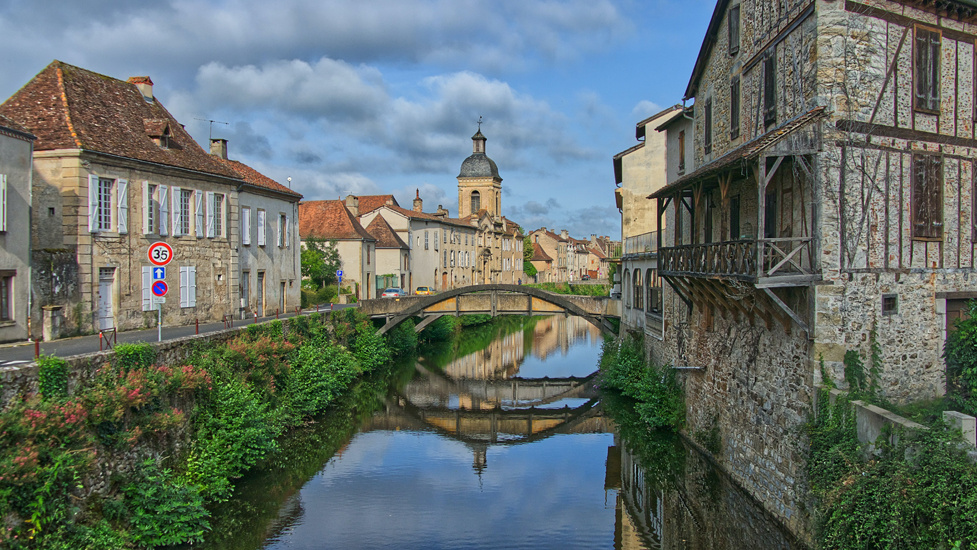Saint-Céré is a A canal-carved medieval city in the Lot department in the Southern Pyrenees, in in the Lot valley , Lot is a department in the Occitanie region of France.in the southwestern part of the country.
Saint-Céret is located at the crossroads of the Bave valley, connecting the Dordogne valley and the Segal mountains with the limestone plateau of Cossse de Gramate. The medieval city of Saint-Céret has successfully preserved its architectural heritage with its old houses, mansions and the beautiful Mercadial square with a fountain, surrounded by beautiful half-timbered houses.
Several famous personalities lived here: Pierre Benoit from the French Academy was inspired by the environment for writing Atlantis and Le dejeuner de Sousceyrac, and the artist Jean Lursa created his tapestries in the workshop of his castle in Saint-Laurent-le-Tour.
The current architecture of the city, with its old streets and medieval houses, still bears witness to the economic activity of the Middle Ages and this rich history of Saint-Céret.
Several famous personalities lived here: Pierre Benoit from the French Academy was inspired by the environment for writing Atlantis and Le dejeuner de Sousceyrac, and the artist Jean Lursa created his tapestries in the workshop of his castle in Saint-Laurent-le-Tour.
The current architecture of the city, with its old streets and medieval houses, still bears witness to the economic activity of the Middle Ages and this rich history of Saint-Céret.
Access : Coordinates:44.8597, 1.8917 / By car: close to the A20 motorway, Saint-Céret is 15 km from Padirac, 25 km from Rocamadour, 70 km from Cahors, 54 km from Brive-la-Gaillarde, 45 km from Figeac and 63 km from Aurillac.
Contents
Saint-Céré is a A canal-carved medieval city in the Lot department in the Southern Pyrenees, in in the Lot valley , Lot is a department in the Occitanie region of France.in the southwestern part of the country.Saint-Céret is located at the crossroads of the Bave valley, connecting the Dordogne valley and the Segal mountains with the limestone plateau of Cossse de Gramate. The medieval city of Saint-Céret has successfully preserved its architectural heritage with its old houses, mansions and the beautiful Mercadial square with a fountain, surrounded by beautiful half-timbered houses.
Several famous personalities lived here: Pierre Benoit from the French Academy was inspired by the environment for writing Atlantis and Le dejeuner de Sousceyrac, and the artist Jean Lursa created his tapestries in the workshop of his castle in Saint-Laurent-le-Tour.
The current architecture of the city, with its old streets and medieval houses, still bears witness to the economic activity of the Middle Ages and this rich history of Saint-Céret.
Highlights :
- The church of the Franciscan Recollects (Église des Récollets) on the banks of the Bave, also single-aisled with a wooden ceiling and a straight choir closure, dates from the 17th century.
- Chateau de Saint-Laurent-les-Tours at St Cere : The origin of the Château de Senin, today the Château de Saint-Laurent-le-Tour (Tours de Saint-Laurent), can be traced back to the 6th century. Its 12th and 14th century towers still dominate the medieval walled city of Saint-Céret until 1713. The great painter Jean Lursa, a restorer of French tapestry, purchased this castle in 1945 and turned it into his workshop, where he worked until his death in 1966. This workshop is still available to the public today (Musée Jean Lurçat).
- The multi-towered castle Château de Saint-Laurent Les Tours, located on a hilltop, dominates the town. During the German occupation of northern France in World War II, it was the artist Jean Lurçat’s second home for years.
- The Château de Montal, about two kilometers outside, is a two-wing renaissance castle from the first half of the 16th century with mighty round towers on the sides that are reminiscent of the Middle Ages.
- Place du Mercadial, its fountain and the 15th century Consuls’ house, listed as a historic monument in 1991./ The 15th century Hôtel de Puymule was listed as a historic monument in 1929.
- Sainte-Spérie Church, dating from the 10th century, listed as a historic monument in 1979 / Church of the Recollets, from the seventeenth century, listed as a historic monument in 1973.
- “Little Venice” : In 1611, to reduce the damage caused by the flooding of the river that crossed Saint-Céret, a Dutch engineer divided the river bed into several channels at the entrance to the city.This is how the city was called “Petite Venise Lotoise“ for 3 centuries.
- Statue of Charles Bourseul (1924) by Giovanni Pinotti Cipriani (also sculptor of the monument to the dead in the square of the Republic Square).- Maison des consuls :
- House of Consuls : Every summer, La Maison des Consuls presents quality exhibitions with a presentation by prestigious artists in the summer and lesser known but equally talented artists the rest of the year.
- Rue Paramelle leads to the Maison Longueval, a 15th century mansion with turrets, and the 15th century Hôtel de Puymule, in a fiery Gothic style. The Church of Saint-Céret contains an 18th-century marble altar and a Carolingian crypt.
- Place du mercadial : Place du Mercadial is a very attractive square with some impressive buildings. The most interesting building on the square is the Maison des Consuls from the 15th century.
- Events : Opera and classical music concerts every summer in July and August. The performances are given in the atmosphere of a 16th century castle.
Activities : sightseeing / photo opportunities / Visit the central squares on market days-Saturdays and Sundays.
Go next : ou can visit the Grottes de Presque cave, opened in 1825 and equipped in 1922, where the highest stalagmite is located./ The idyllic villages Loubressac and Autoire are about 10 and 7 kilometers to the west./ In the southwest of Saint-Céret, be sure to visit Rocamadour and the Padiraca Cave, in the south you will find the beautiful historic town of Figeac.

